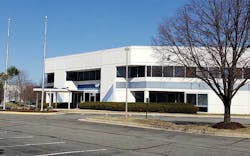Digital Realty Preps New Project Near Key Internet Intersection
Digital Realty is ready to begin building a data center at a prime location in Data Center Alley in Ashburn, Virginia. The company, which is already the largest player in the Ashburn market, plans to create its 40-megawatt Digital Filigree development on a 13-acre parcel the company purchased in 2019.
The project will take two to three years to complete. Why so long? Because there’s a building on the site already, which will need to be demolished to make way for a purpose-built data center. Once it arrives, Digital Filigree will be of immediate interest due to its strategic location.
The property is adjacent to a cluster of data center buildings operated by Equinix, which specializes in making the physical connections that tie the Internet together. Data Center Alley has become the focal point for deploying cloud computing capacity, and the Equinix campus in Ashburn is the region’s primary network intersection. That’s why “Distance to Equinix” has become a key metric in procuring sites for new data centers in Northern Virginia.
On one level, the fact that Digital Realty is building a new data center in Ashburn is hardly news. The developer’s construction projects have been going non-stop for years, including the current construction on Building R, the latest data center on its massive Digital Loudoun campus.
These projects are part of a building boom in Northern Virginia, as data center developers race to keep pace with the growth of cloud computing platforms. The supply of data center capacity in North America has grown 17.5 percent over the past year, according to research firm datacenterHawk. New space is being absorbed rapidly in markets like Northern Virginia, where the vacancy rate for data center space is less than 2 percent, according to Cushman & Wakefield.
Digital Filigree also reflects an evolution in data center development, as more builders acquire properties with existing structures as the supply of open land diminishes. This is a trend to watch in Northern Virginia, where housing the servers that power the cloud has become a real estate challenge.
Expanding Footprint in Northern Virginia
With more than 285 data centers in 26 countries and 50 cities, Digital Realty is one of the world’s largest data center operators. In its most recent quarter, the company leased 94 megawatts of data center capacity, reflecting the strong global growth of IT infrastructure.
Nowhere is the collective impact of Digital Realty’s scale more visible than here in Ashburn, a town in Loudoun County which sits atop the world’s densest intersection of fiber networks, making it an ideal location to store and distribute data.
Digital Realty already operates two massive campuses in Ashburn, including the original Digital Ashburn campus which houses 10 huge data centers near the Dulles Greenway, and the Ashburn Corporate Center (ACC) developed by DuPont Fabros, which features seven data centers. The company leases about 3.4 million square feet of data center in Northern Virginia.
In addition to its built infrastructure, Digital Realty controls a substantial “land bank” of property for future development. This includes:
- Digital Dulles, a 424-acre piece of land next to Dulles Airport, also known as the Western Lands. The Digital Dulles campus will create 7.5 million square feet of new data center space over a 15-year period.
- Digital Sterling, a 22-acre site along Route 28 and Pacific Boulevard in Sterling that has received approval for data center use.
- A 62-acre parcel in Manassas in Prince William County, which has seen strong growth as a more affordable alternative to Ashburn.
Real Estate Availability, Values Impact Strategies
Nearly all of Digital Realty’s existing data centers in Ashburn have been “greenfield” projects, constructed on vacant land. With open land dwindling, developers must buy commercial properties and knock down the existing buildings to make way for purpose-built data centers. Digital Filigree is one example of this trend, which has become the prevailing strategy in Santa Clara, the leading data center hub in Silicon Valley, which is effectively out of development parcels of open land.
These projects reflect the new reality for real estate in tech corridors: In some neighborhoods, the highest value for any piece of land will be for data centers. That’s been the case in Santa Clara, where Amazon Web Services recently paid more than $7 million an acre to buy a 7-acre parcel on a prime site near the Intel headquarters campus.
Construction on a future data center for AREP in Ashburn, Virginia. (Photo: Rich Miller)
In Ashburn, the focus of the knock-down redevelopment trend has been the industrial park surrounding the original Equinix hub. Two properties on Beaumeade Circle will feature new purpose-built data centers to replace existing structures, including a new AREP data center campus and a Cologix project on the former site of the Christian Fellowship Church. About a mile down the road, the former America Online campus in Ashburn is expected to be knocked down and converted into a large data center campus.
The strong demand for cloud computing capacity means that data center developers are constantly accumulating land in Northern Virginia. As development parcels dwindle and demand continues apace, property values continue to rise.
That’s reflected in the AOL transaction, with local media reporting a sale price of $136 million for the 43-acre site, or about $3.14 million per acre. By comparison, Digital Realty paid about $2.1 million an acre in 2019 when it acquired the Digital Filigree site from Airbus Americas.
About the Author



